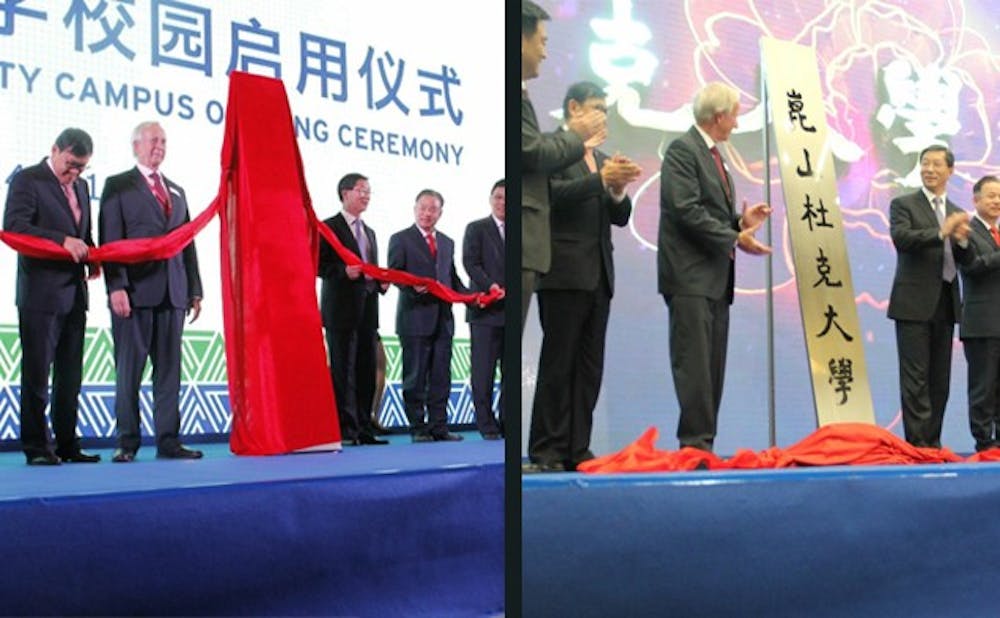KUNSHAN, China—Leaders from Duke, Wuhan University and the municipal government of Kunshan discussed the impact of Duke Kunshan University on the future of Sino-American relations during the second day of DKU's grand opening event.
Prior to an afternoon of celebratory speeches, guests were given a series of tours and invited to sign DKU commemorative banners. The list of speeches included talks both in English and in Chinese, so guests were given headsets in order to listen to a professional translation as the speeches occurred. Among the lineup were DKU Chancellor Liu Jingnan, Duke President Richard Brodhead, Wuhan President Li Xiaohong and Cen Jianjun, director general of the cooperation department of the Ministry of Education.
“On this happy day, Duke is profoundly grateful for the strong support we’ve had from our partners,” Brodhead said. “The city of Kunshan originated the idea of DKU—they have been our faithful partners and have done everything to let this dream become a reality.”

The event started off with a Chinese lion dancing performance, in which Peter Lange, former provost and current chair of the DKU Board of Trustees, and Mary Brown Bullock, executive vice chancellor of DKU, painted the lions’ eyes.
Jingnan then kicked off the afternoon's speeches, noting DKU’s obligation to address issues plaguing society through the use of different teaching styles brought by American and Chinese educational systems.
The theme of tying together American and Chinese educations in the service of addressing societal problems continued throughout the day. Brodhead noted that Duke had been interested in building a campus in Kunshan because so many of the University’s research components have Chinese dimensions to them.
“How can one study environment without studying China and the rest of the world?” he posed. “How can one study health without studying one of the largest populations in the world?”
There is a long history of Chinese and Americans exchanging ideas and learning from each other’s techniques, Jianjun noted. For example, pioneers in Chinese painting traveled overseas to learn western painting techniques, which they then integrated into art schools and their own work.
“So today, when we establish the development of DKU, it’s another celebration of the integration of East and West,” he said. “The establishment of DKU is going to create a new school of learning.”
In an interview following the speeches, Lange noted that thought DKU could never solve the problems between the United States and China, it could certainly help. He said there is an immense amount one can learn simply through meeting people from a different culture and living in a new environment.
“It’s also meant to inspire innovation on Duke’s campus as well,” he said of the Kunshan campus. “Faculty will come back and say they tried something and think, ‘huh, now maybe I’ll try that here.'”
China is the fifth most popular destination for American students studying overseas, said Thomas Hodges, minister counselor of the public affairs section of the U.S. embassy. In 2009, President Barack Obama called for 100,000 students to visit China when he visited Shanghai. In his most recent visit to China last week, Obama announced that America had reached that goal.
Hodges added that China has had a large contingent of students in the United States for many years, and that this number will grow even more this year.
“The opening of DKU is not only an auspicious occasion but also represents a significant step in Chinese-U.S. educational relations,” he said. “Far-thinking individuals from these three institutions have recognized the trend we’ve seen over the years in terms of the growth and mutual interests in two educational systems.”
The event celebrated not only what DKU means for the future of American-Chinese educational relations but also the three-way partnership between Duke, Wuhan University and the city of Kunshan that created DKU.
Leaders from all three institutions presented a plaque with DKU’s name written in calligraphy in the style of Gu Yanwu, a Kunshan native and Ming dynasty loyalist whose works provided a basis for a 19th century movement to intertwine Western learning with Chinese tradition. One of Kunshan's main attractions is a memorial honoring Gu Yanwu’s contributions in Tinling Park.

Bullock noted that the DKU logo, a series of three triangles that creates a mountain, is meant to represent the strength of the three-way partnership. The triangular shape is meant to represent the “trinity spirit” of the institution. Each school is represented in an individual triangle—in Duke blue, Kunshan jade and Wuhan green.
“The mountain peak with its gradually deepening color represents continuing progress,” Bullock said, with tears in her eyes. “Some see a bamboo shoot coming out of the ground representing a new beginning.”
DKU scholarship donors and campus builders were given plaques to honor their contributions to creating the university. Provost Sally Kornbluth also helped unveil a plaque demonstrating the partnership between Wuhan University and Duke to create DKU.
Kennedy Opondo, a student from Kenya who is pursuing a master’s of science in global health, gave a speech thanking the donors for giving him the opportunity to study at DKU.
An earlier version of this story misstated the name of a student. His name is Kennedy Opondo, not Opondo Kennedy. The Chronicle regrets the error.
Get The Chronicle straight to your inbox
Signup for our weekly newsletter. Cancel at any time.

